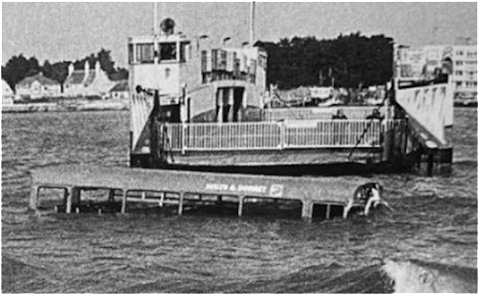Sandbanks Ferry has provided a vehicle and passenger crossing between Sandbanks and Studland since 1926. This avoids the 25 mile journey around Poole Harbour. First ferry crossing was on 15th July 1926 and was coal fired and steam driven.
In 1904, the Branksome & Swanage Light Railway Scheme had proposed the
construction of a tramway between Canford Cliffs and Swanage. A tower was to be
erected on either side of the water and by means of a gondola the tram cars would
be swung across the water enabling them to continue on their way onto Swanage.
The Branksome & Swanage Light Railway Scheme was unable to obtain the approval of the Poole Harbour Commissioners for their plan and as there was strong local opposition it was never built. Also, early in the 20th
century, there had been a rowing boat crossing which operated only during the
summer.
Built by an Isle of Wight shipbuilder, the first Sandbanks Ferry
remained in service for more than 30 years. Despite only able to carry 15 cars, in its first year it reportedly transported some 12,000 cars and 100,000
passengers. Back in 1929, the ferry company also tabled proposals to build a
bridge but this failed to obtain the necessary House of Commons approval.
During World War II, the ferry was taken over by the military and closed to the
public.
Life with the Sandbanks Ferry has not been without incident.
In 1986, a Swanage to Bournemouth Wilts & Dorset bus ran down the ramp at
Studland into the sea. Stuck in the sand and a hazard to shipping, the
single-decker, with the help of the Royal Marines, was towed out the briny the
next day. A similar incident occurred in April 2009 when an unoccupied Smart
car was spotted floating by the Haven Hotel. Although the driver reckoned he
had left the hand break on, the not so smart vehicle had still rolled down the
ramp into the briny at Sandbanks.
Current chain link ferry is the Bramblebush Bay which is the
first of the four different Sandbanks ferries to be named. It can carry 48 cars
and operates on steel chains 1,235 feet long.
(Credit: Bournemouth Echo & BBC.)



Comments
Post a Comment